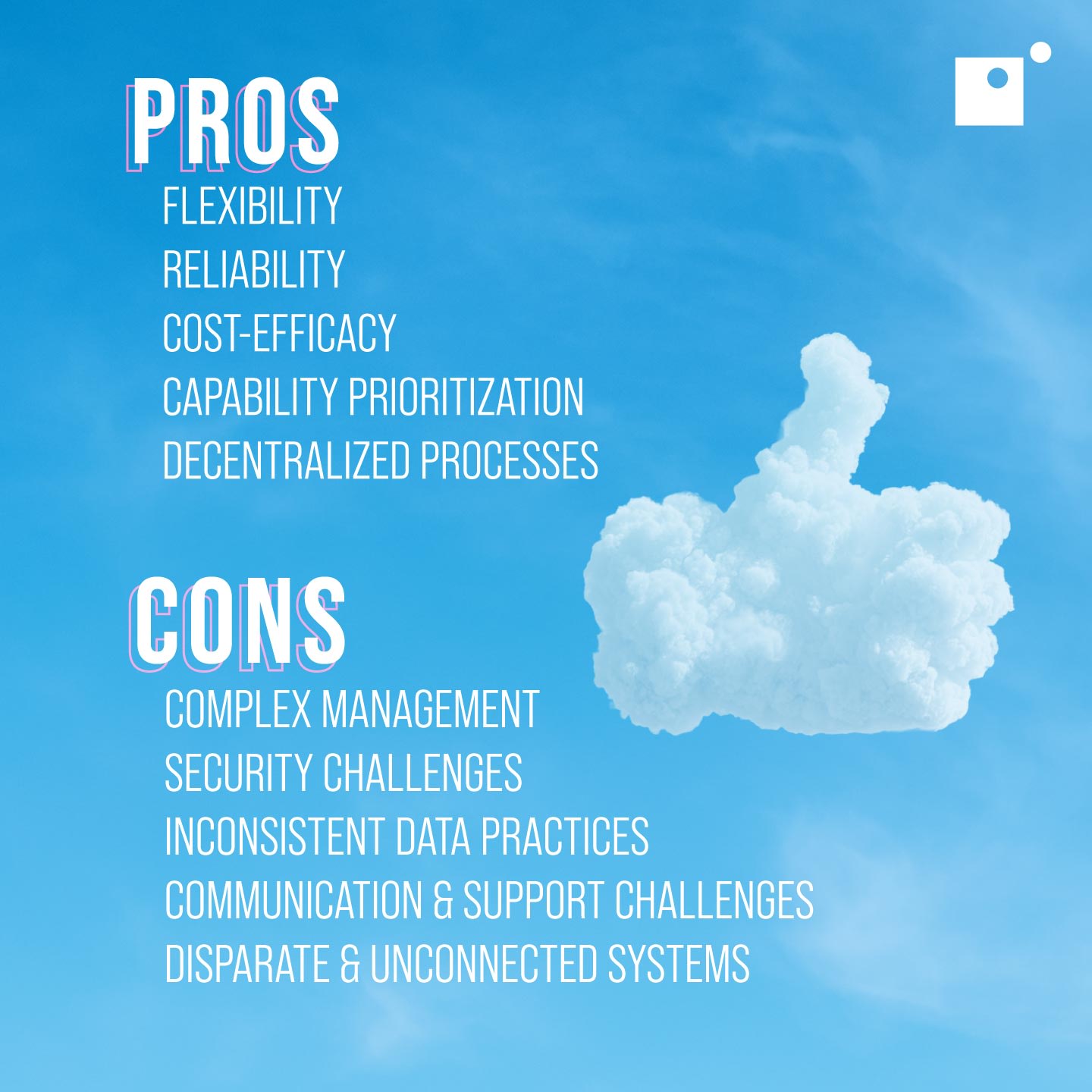Organizations are often trying to figure out if it’d be better to consolidate their operations under a single cloud provider or distribute workloads across multiple platforms. The multi-cloud strategy—leveraging two or more cloud services—has gained traction as businesses seek flexibility, resilience, and access to best-in-class tools.
Yet, this approach is not without its challenges.
From cost and complexity to security and performance, the debate around multi-cloud versus single solution is nuanced and evolving. This piece explores the core arguments on both sides, helping decision-makers weigh the trade-offs and determine which strategy best aligns with their goals, resources, and risk tolerance.
For more information on integrating technology successfully the first time, check out Impact’s webinar, Why Your Tech Rollouts Fail (and What to Do About It).
Multi-Cloud vs Single Solution
When organizations consider cloud architecture, one of the first strategic decisions they face is whether to adopt a multi-cloud approach or commit to a single cloud provider. This choice has far-reaching implications for performance, cost, security, and operational complexity.
A multi-cloud strategy involves using services from two or more cloud providers. This can be done to avoid vendor lock-in, leverage the best services for your specific needs, or meet geographic and regulatory requirements.
On the other hand, a single cloud solution centralizes all workloads and services under one provider, simplifying management and potentially reducing costs through volume discounts and streamlined support.
The decision between these two models often hinges on an organization’s size, industry, risk tolerance, and technical maturity. While multi-cloud offers flexibility and resilience, it also introduces complexity and, in worst cases, disparate systems.
A single solution may be easier to manage, but could limit innovation or an organization’s ability to customize their suite of solutions.
Multi-Cloud Pros and Cons
Adopting a multi-cloud strategy can offer organizations a wide range of benefits, but it also introduces new layers of complexity and risk. Understanding both sides of the equation is essential for making an informed decision.
Pros of multi-cloud:
- Avoiding Vendor Lock-In: By distributing workloads across multiple providers, organizations reduce dependency on any single vendor, gaining leverage in pricing and service negotiations.
- Resilience and Redundancy: Multi-cloud architectures can improve uptime and disaster recovery by enabling failover between platforms.
- Optimized Performance: Teams can route workloads to the cloud provider with the best regional performance or specialized capabilities.
- Hand-Picked Services: Each cloud provider has unique strengths—multi-cloud lets organizations cherry-pick the best tools for each task.
- Regulatory Flexibility: Multi-cloud can help meet compliance requirements by storing data in specific geographic regions or under different jurisdictions.
- Innovation Enablement: Developers can experiment with new services across platforms without being constrained by a single ecosystem.
Cons of multi-cloud:
- Operational Complexity: Managing multiple platforms requires more sophisticated tooling, governance, and expertise.
- Security Challenges: Ensuring consistent security policies and monitoring across providers can be difficult and error-prone.
- Higher Costs: Without careful planning, multi-cloud can lead to duplicated services, inefficient resource use, and increased overhead.
- Talent Requirements: Teams must be proficient in multiple cloud environments, which can strain hiring and training budgets.
- Fragmented Tooling: Integrating and orchestrating services across clouds often requires custom solutions or third-party platforms.
- Data Governance Issues: Tracking data movement and access across providers can complicate compliance and auditing.
While the advantages of a multi-cloud strategy are compelling—especially for organizations seeking flexibility, resilience, and access to specialized services—the drawbacks are equally important to consider.
The added complexity, cost, and security challenges can quickly outweigh the benefits if not managed with a clear strategy and the right expertise. Ultimately, the success of a multi-cloud approach depends on how well it aligns with an organization’s goals, resources, and ability to navigate the intricacies of a distributed cloud environment.
Single Solution Pros and Cons
Choosing a single cloud provider is often seen as the simpler, more streamlined alternative to multi-cloud. For many organizations—especially those early in their cloud journey or operating with limited resources—this approach offers clarity, consistency, and operational efficiency.
But like any strategic decision, it comes with trade-offs.
Pros of a single cloud solution:
- Simplified Management: With one provider, teams can focus on mastering a single platform, reducing the need for cross-training and complex orchestration.
- Cost Efficiency: Consolidating services often leads to volume discounts, reduced overhead, and easier cost tracking.
- Unified Security Posture: Security policies and monitoring tools are easier to implement and maintain across a single environment.
- Streamlined Support: Troubleshooting and vendor communication are more straightforward when dealing with one provider.
- Faster Onboarding: New team members can ramp up more quickly when there’s only one cloud ecosystem to learn.
- Better Integration: Native services within a single cloud often work together seamlessly, reducing the need for custom connectors or third-party tools.
Cons of a single cloud solution:
- Vendor Lock-In: Relying on one provider can limit flexibility and negotiating power, especially if pricing or service quality changes.
- Limited Service Options: No single provider excels at everything—some workloads may be better suited to other platforms.
- Reduced Resilience: A single point of failure can pose risks to uptime and disaster recovery.
- Geographic Limitations: Some providers may not offer optimal performance or compliance coverage in all regions.
- Innovation Constraints: Teams may miss out on cutting-edge tools or features available only on competing platforms.
While a single cloud solution offers simplicity and efficiency, it may also restrict an organization’s ability to be creative with their cloud solutions.
The key is to assess whether the benefits of centralized control, integrated systems, and higher security protocols outweigh the potential limitations in flexibility—especially as business requirements evolve.
Cybersecurity Considerations for Multi-Cloud Solutions
A multi-cloud strategy can offer resilience and flexibility, but it also introduces significant cybersecurity vulnerabilities. Each cloud provider operates with its own infrastructure, policies, and interpretations of the shared responsibility model.
As organizations stretch their operations across these varied environments, maintaining consistent security controls becomes increasingly difficult. Fragmented identity systems, access policies, and monitoring tools can create blind spots—areas where threats go undetected or misconfigurations go unnoticed.
These risks are amplified in today’s climate of deregulation. With oversight mechanisms weakening and enforcement becoming less predictable, organizations are often left to navigate a patchwork of regional laws and industry standards on their own.
In a multi-cloud setup, this can result in inconsistent compliance practices and heightened legal exposure, especially when sensitive data crosses borders or resides in jurisdictions with conflicting privacy rules. The lack of centralized governance makes it harder to ensure that data protection standards are uniformly applied.
Despite these challenges, multi-cloud security is not inherently flawed. It simply demands a more sophisticated approach. Success depends on building a cohesive cybersecurity framework that treats the cloud ecosystem as a unified whole rather than a collection of silos.
Without that foundation, the flexibility that makes multi-cloud attractive can quickly become a liability, exposing organizations to threats they may not be equipped to handle.
The Argument for Centralized Solutions
In contrast to the complexity of multi-cloud environments, centralized cloud strategies offer a streamlined alternative that appeals to organizations seeking simplicity, control, and predictability.
By consolidating operations under a single provider, businesses can reduce the overhead associated with managing multiple platforms and instead focus on optimizing within a unified ecosystem. This approach often results in faster deployment cycles, clearer accountability, and more consistent performance across services.
Centralization also strengthens governance. With one provider, security policies, compliance frameworks, and operational standards can be applied uniformly, reducing the risk of misalignment or oversight. Teams benefit from a single set of tools and interfaces, which simplifies training and collaboration.
Moreover, centralized solutions often come with stronger vendor support and service-level agreements, giving organizations confidence in their ability to scale and recover from disruptions.
While centralized strategies may limit flexibility and expose organizations to vendor lock-in, they offer a compelling value proposition for those prioritizing stability and efficiency.
Especially in industries with strict regulatory requirements or limited technical resources, the clarity and cohesion of a single-provider model can outweigh the theoretical advantages of multi-cloud. For many, the argument for centralization is not about avoiding innovation—it’s about enabling it through focus and consistency.
Final Thoughts on Multi-Cloud vs Single Solution
There’s no one-size-fits-all answer when it comes to cloud strategy. Multi-cloud offers flexibility, resilience, and access to a broader range of services—but it demands a high level of coordination, technical maturity, and security oversight.
A single cloud solution, by contrast, provides simplicity, consistency, and centralized control, which can be especially valuable for organizations with limited resources or strict compliance requirements.
The decision ultimately hinges on what your organization values most: adaptability or efficiency, innovation or stability, control or reach. Both strategies have merit, and both carry risk. What matters is aligning your cloud architecture with your business goals, operational capacity, and long-term vision.
As cloud technologies continue to evolve, so will the arguments for and against each approach. The key is not to choose the “right” strategy once and for all, but to remain agile—ready to reassess, recalibrate, and respond to the changing demands of your business and the broader digital landscape.
Watch Impact’s webinar, Why Your Tech Rollouts Fail (and What to Do About It), for more information on integrating new technologies into your business workflows successfully the first time.



